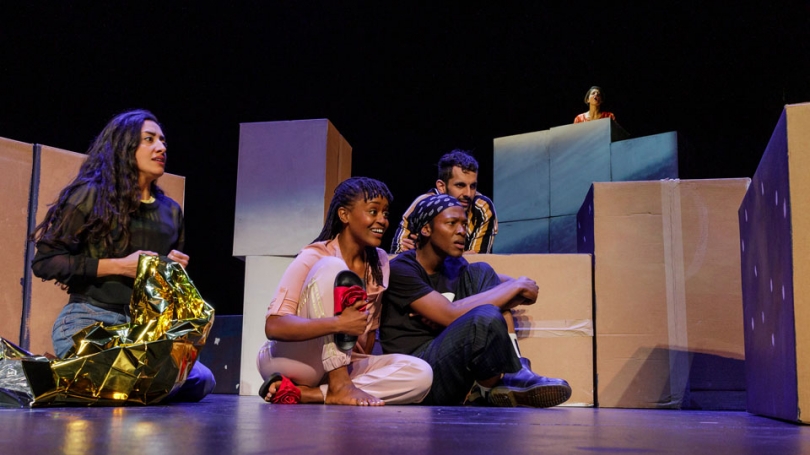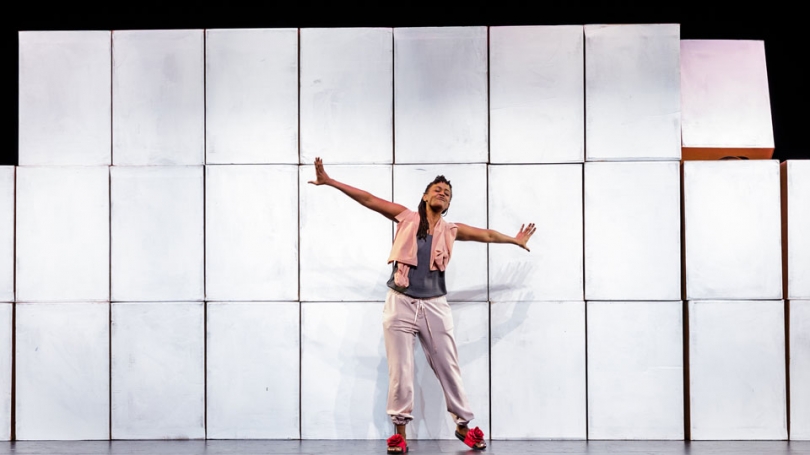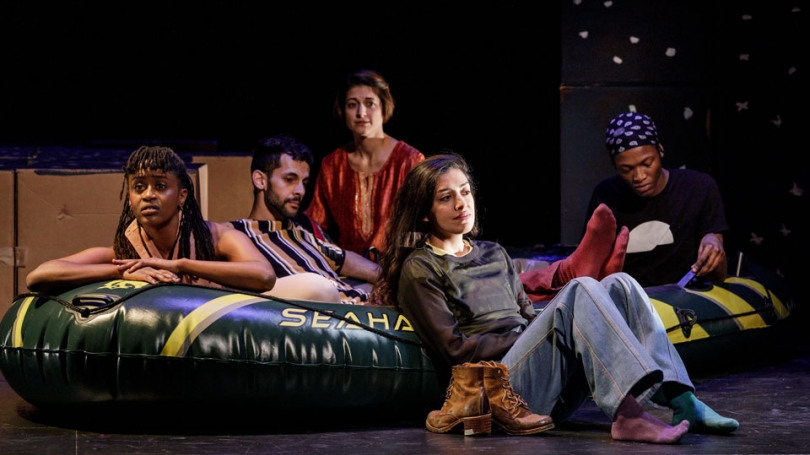Using small stories to build big new worlds
Although the COVID-19 pandemic postponed the Hop's spring programming, the Hop and Vermont's Northern Stage were able to move onto digital media a highly anticipated workshop connecting Hop visiting artists with Upper Valley youth. Here's a snapshot of that powerful conversation.
I entered the Zoom session with an awkward jolt as if I had just taken a poorly timed step off a moving walkway. When you join a Zoom meeting, you just appear, landing abruptly from a jaunt in the digital airwaves. A sea of young faces from across the Upper Valley were waiting, each in their own neat Zoom boxes. We were all gathered to participate in an interview-based theater and writing workshop with actor and director Kaneza Schaal and author, designer and fine artist Christopher Myers. These artists are the ingenious engineers of Cartography, a devised documentary play about young refugees that the Hop had planned to present this spring. A theater artist myself, in-person connection and communication is integral to my work and the work that moves me most; I was curious about how these artists would approach a theater workshop in a medium that reconfigures those sensory instincts.
Never did I imagine that a group of theater artists (or that any of us) would be here. Just as COVID-19 reached the U.S., Eric Love (Northern Stage's director of education) and I had been planning a workshop with Cartography artists and Northern Stage's young actors, who already had experience creating interview-based theater. The youth's production Stories of White River Junction from last fall staged interviews that the actors had conducted with White River Junction's community members. When the pandemic halted in-person rehearsals and performances, Eric made lemonade out of lemons, conceiving the documentary theater project Portraits of the Pandemic in which youth both craft and are the subjects of creative writing portraits. Through weekly writing prompts and Zoom meetings, students in grades 6–12 track their experiences with the pandemic and build creative content that will make its way into a performative product.
Eager to bring Cartography's creators in conversation with this dynamic group of young actors, Eric and I forged ahead with a virtual workshop in consultation with Kaneza, Chris and Cheyanne Williams, the show's technical director. In our current moment, how could we work together to write about a crisis, a topic which the artists handle with such great care in their show?
Chris and Kaneza began the workshop with palpable energy and generous urgency; we would make the most of this time. They began discussing their approach to making Cartography, which began in 2016 when the artists facilitated storytelling workshops in Munich, Germany, with young refugees from all around the world. A defining moment was when two young women, one from Nigeria and the other from Syria, excitedly discovered they had both been on boats in the Mediterranean. This small yet powerful shared experience inspired the Cartography team to hone in on specific moments and small lenses to access stories about broader experiences.
Chris and Kaneza explained how these lenses helped them elicit some of the hardest, scariest stories in a way that journalists and news reports don't often tell them. They recalled that during the workshops in Munich, the young people created soundscapes of their homes and a boy started yelling "Pow pow pow," recreating the sound of gunshots. Focusing the storytelling lens and framework opened the door to some of the young refugees' darker realities.
Chris then asked us, "What is the smallest way you can talk about the biggest thing?" and invited us to brainstorm small lenses we could use to tell a bigger story. Young actor Isabelle Ackerman talked about all the paintings she has been doing. Hannah Malin Stremlau discussed the sounds one used to hear that you either miss or don't miss. Hugh Wendling mentioned the number of trees he has climbed, and the astute observation that he climbs higher on Fridays than any other day of the week.
Next, Chris instructed us to write a short diary entry from the perspective of something other than ourselves. Olivia Swayze wrote as if she was her car, frustrated by stagnation and anxious to grind its gears down the road. Flynn Moreno wrote a diary entry as if she were the trees in her yard, watching her family's altered routine. I wrote from the perspective of my couch, which I now see in a whole new way: "But I feel her weight, and she's heavy. Not because she's gained physical weight … but it's something else. She's heavier. And I'm glad I'm here to carry her weight."
The writings touched on complex feelings of loss, loneliness and fatigue, but also humor and delight. Finn Powers's diary entry was written from the perspective of a curious but unintelligent bird wondering about the recent lack of park visitors. He wrote, "The monkeys there [assumedly referring to humans] give me food." Gunnar Langhus's overused chair griped, "It's the seventh week and I'm never going to be the same." Gloomy sighs and joyful chuckles danced together.
At the end of the session, Isabelle asked Chris and Kaneza about what creates a magical story and how that story changes one's life and perspective. Kaneza responded, "Stories build everything in our world. It's a way of dreaming and making the world into being." Eric noted how Chris's writing prompts helped open up new lenses and perspectives that will influence the student's future writing and the worlds they build. As we prepared to sign off, I scanned the mosaic of Zoom windows, each of us coming together to use theater and storytelling to make sense of this wild world and begin to imagine a new one—a small way to do a big thing.
Want to explore the stories of Cartography with your own family members or students? The show's educational study guide includes video excerpts of the performance with discussion questions and activities that can be adapted to remote learning formats. Find it here.
The creators of Cartography also had a virtual discussion with Dartmouth Professor Eng-Beng Lim's class "Intro to Race, Migration, and Sexuality Studies," and will visit Professor Kenneth Bauer's anthropology class "Cartographic Encounters" later this month.


